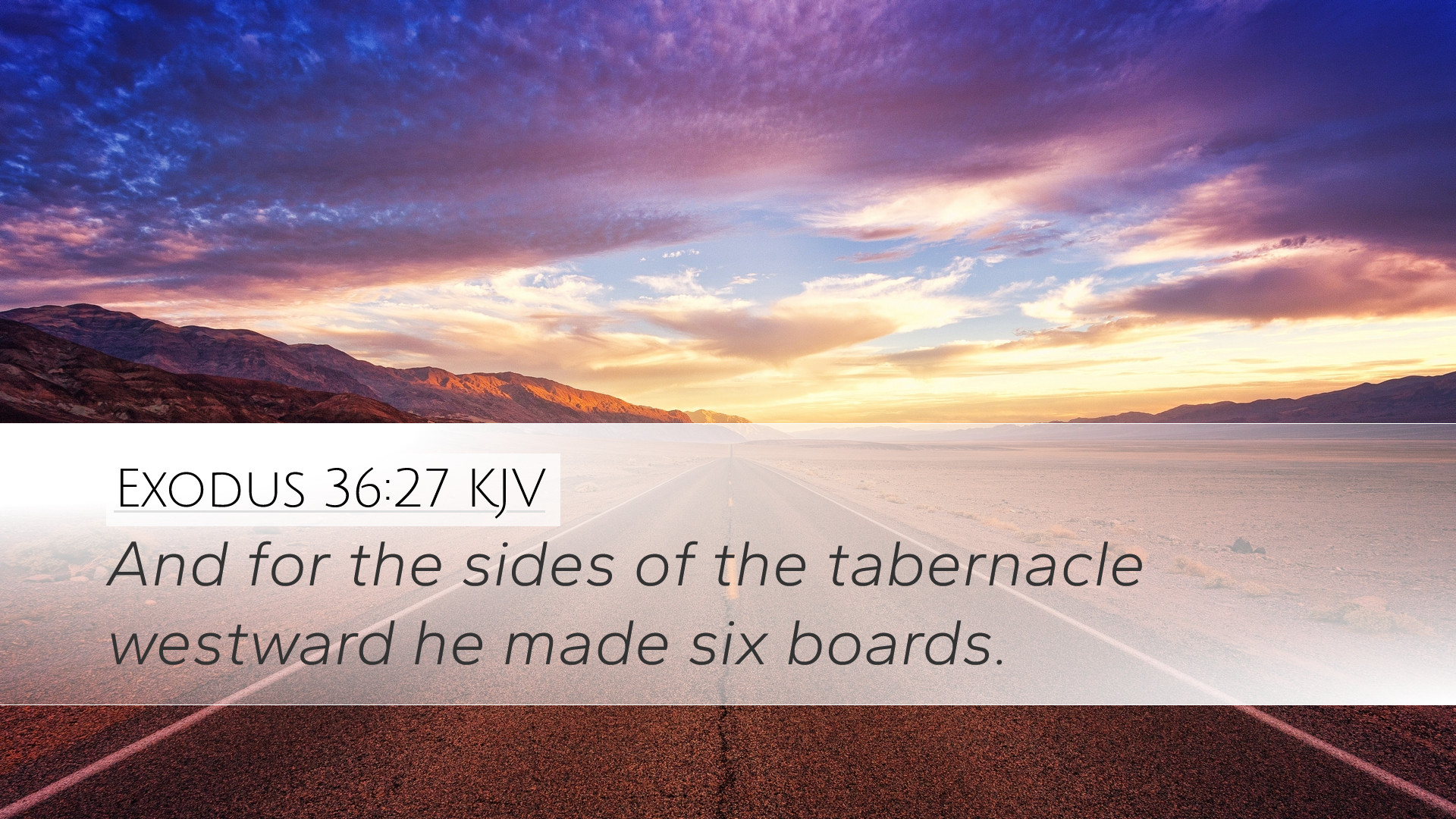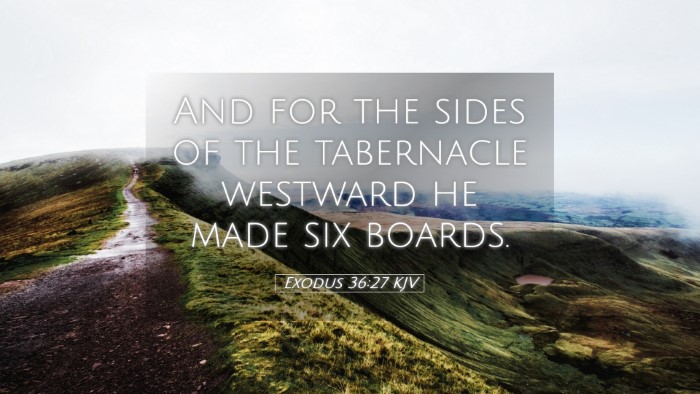Exegetical Commentary on Exodus 36:27
Verse Context: Exodus 36:27 states: "And for the parts of the tabernacle that were boards, the same are the boards of the tabernacle that are for the habitation, the boards were made of what? the same were the boards of the tabernacle. Each board was ten cubits long and a cubit and a half wide."
Introduction
This verse is part of the detailed instructions and the account of the construction of the tabernacle, God’s dwelling place among His people. In Exodus chapters 25 to 40, we find extensive description of the materials, dimensions, and arrangements necessary for the tabernacle. It emphasizes not only the significance of the tabernacle in Israel's worship but also the divine specifications for its construction that exemplified God's holiness and presence.
Commentary Overview
The insights from various public domain commentaries shed light on different elements of this verse, specifically focusing on the boards used for the walls of the tabernacle, their significance, and how they reflect broader theological concepts.
Matthew Henry’s Commentary
Matthew Henry emphasizes several key points regarding this verse:
- Material of Boards: He notes that these boards were made of shittim wood (Acacia wood), which symbolizes durability and resilience, fitting for a structure intended to house the divine presence.
- Dimensions and Construction: Henry highlights the precise measurements of the boards, underscoring God’s attention to detail. Each board's height and width reflects the perfection and order God established in His worship.
- Theological Implications: The use of boards in the tabernacle represents the individual believers whose lives contribute to the overall structure of the church—the body of Christ. Just as every board was critical to the tabernacle's strength, so is each believer to the community of faith.
Albert Barnes’ Notes on the Bible
Albert Barnes provides insightful analysis, concentrating on:
- Symbolism of the Tabernacle: He relates the tabernacle's structure to the concept of God's presence. The boards function as a boundary that defines the sacred space, illustrating how God dwells with His people amidst the complexity of sin and separation.
- Unity and Order: Barnes underscores the importance of assembly and cohesion among the boards. This reflects the calling of believers to unity in the body of Christ, emphasizing that division leads to weakness in spiritual communities.
- Divine Instructions: He mentions how these explicit instructions highlight God’s desire for a relationship with His people, establishing that worship should be conducted in accordance with divine guidance.
Adam Clarke’s Commentary
Adam Clarke's perspective provides a comprehensive understanding, focusing on:
- Historical Context: Clarke discusses the historical significance of the tabernacle as a pivotal point of worship for the Israelites. He maps out the role of the tabernacle in their journey to the Promised Land, symbolizing God’s guidance.
- Construction Details: He elaborates on the diverse responsibilities in the construction process, which speaks to the collaborative nature of ministry in the church today, highlighting the necessity of every individual’s contribution.
- Nature of God's Presence: Clarke reflects on God’s evolving relationship with humanity, emphasizing how the tabernacle served as a precursor to the ultimate revelation of God through Christ.
The Importance of the Tabernacle
Throughout Exodus, the tabernacle is not merely a construction project; it symbolizes the relationship between God and His people.
- Presence of God: The architectural design of the tabernacle points to the holiness of God. The materials and their arrangement serve as a visual reminder of the grace that allows sinful humanity to draw near to a holy God.
- Covenant Relationship: The specificity of the boards’ dimensions underscores the covenant relationship, emphasizing that God's standards and specifications are integral to maintaining fellowship with Him.
- Foreshadowing Christ: Many theologians note that the tabernacle foreshadows Christ, the ultimate dwelling place of God among men, who fulfilled the requirements of the law and served as the perfect mediator.
Conclusion
Exodus 36:27 serves as a reminder of God’s meticulous care in establishing worship practices that are holy, orderly, and reflective of His presence. The diverse insights from Matthew Henry, Albert Barnes, and Adam Clarke combine to illustrate the profound truth about the communal aspect of faith, the importance of worship in spirit and truth, and the ultimate fulfillment of God’s promise through Jesus Christ. Understanding these elements enriches the faith and encourages deeper reflection on how believers fit into God's design, contributing as vital parts of His kingdom.
As we contemplate the construction of the tabernacle, may we also build our lives according to God’s glory and engage actively in the community of believers, embodying His presence in a world in desperate need of hope and redemption.


